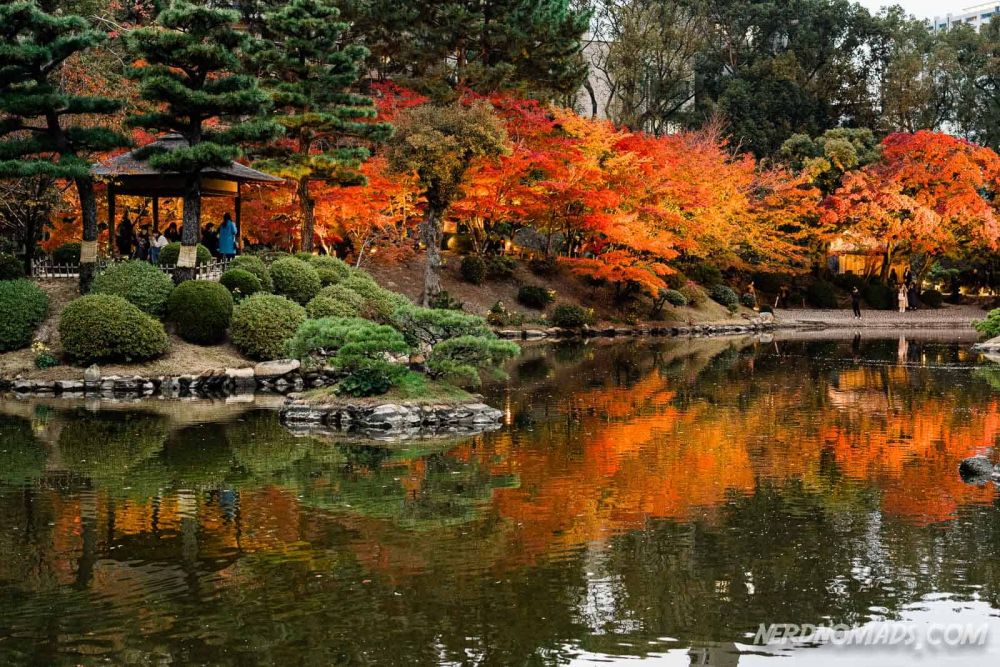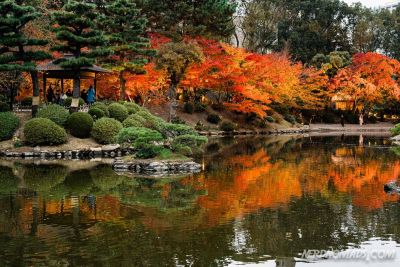

Experience the tranquil beauty of Shukkeien Garden with a detailed guided tour. Immerse yourself in the rich history and cultural significance as an expert guide takes you through the various features of this scenic spot, meticulously designed to represent miniature valleys, mountains, and forests. The gardens date back to 1620 and have been a place of solace and beauty for centuries. Witness the art of traditional Japanese garden design, where every bridge, koi pond, tea house, and carefully pruned tree is placed to create an aesthetic journey representing the landscapes of Japan. The tour delves into the garden's philosophy, horticultural practices and provides insight into the unique plants and wildlife within the grounds. It's an educationally enriching experience that connects you with the history and natural beauty of Hiroshima.
Partake in the serene ritual of a Japanese tea ceremony, set in the traditional tea houses of Shukkeien Garden. This is an activity that allows you to connect with Japanese culture on a profound level. The tea ceremony, also known as Sado or Chanoyu, emphasizes respect, purity, tranquility, and harmony. You will be guided by a tea master through the intricate steps of preparing and serving matcha, the finely ground Japanese green tea, alongside traditional Japanese sweets. This ceremony is a sensory journey, engaging you in the sight, sound, and taste of the traditional art form while surrounded by the garden's natural splendor. Learn the importance of each gesture and item used in the ceremony, symbolizing a bond between host and guest and offering a moment of peace in today's busy world.
Shukkeien Garden is celebrated for its seasonal transformations, which showcase a variety of blooming flowers throughout the year. Hanami, or flower viewing, is a popular Japanese activity, especially when cherry blossoms (sakura) adorn the trees in spring. Visitors can stroll along the pathways lined with blossoming cherry trees, appreciating the ephemeral beauty of the flowers. The garden also boasts azaleas, plum blossoms, and colorful autumn leaves at different points in the year, each providing a unique spectacle. Benches and open areas are available for visitors to sit, relax, and enjoy the seasonal tapestry of colors. Photography enthusiasts, in particular, will find these periods optimal for capturing the beauty of Shukkeien. The garden's design ensures that each season offers a different experience, making it a place worth visiting multiple times throughout the io
Shukkeien Garden offers an inspiring setting for artists and enthusiasts to indulge in plein air painting, a traditional form of art where paintings are created outdoors. Artists of all skill levels are welcomed to set up their easels amidst the garden’s landscapes. Capture the harmonious blend of water, stone, and flora with your brush strokes, whether you prefer watercolors, oils, or acrylics. The vibrant koi in the ponds, quaint bridges, and intricate pine trees provide an array of attractive subjects. It's not just an art session; it's a chance to calm the mind and observe the subtle interplay of light and shadow in one of Hiroshima's most scenic spots. While you immerse yourself in painting, you're also likely to attract an appreciative audience of fellow visitors who will be curious to see your interpretation of the garden's beauty.
Shukkeien Garden is a delightful venue for enthusiasts of bonsai, the traditional Japanese art form of growing miniature trees in containers. The garden hosts a selection of carefully cultivated bonsai trees, varying in species and styles. These tiny, living sculptures are indicative of patience and careful tending, some being centuries old. Visitors can admire these bonsai trees, gleaning insight into the meticulous care they require, including trimming, wiring, watering, and repotting. Engage with gardeners to learn about the philosophies behind bonsai cultivation and the influence of nature on this art form. Observing these miniature masterpieces is a window into the larger surrounding landscape of the garden, as bonsai represents the essence of the natural world in a smaller scale. This activity is both educational and marvelously meditative.
Photography enthusiasts can embark on a visually rich journey as they navigate the intricate pathways of Shukkeien Garden. Every nook of this compact garden offers a photogenic scene, ideal for both amateur and professional photographers. Capture the reflections of trees in the glassy ponds, the stone lanterns that dot the landscape, and the charming architecture of the tea houses. Seasonal changes present new themes for photography, from the fresh hues of green in spring to the fiery colors of fall foliage. Shukkeien is a playground for composition, lighting, and texture, making it a sought-after destination for those looking to add captivating nature and cultural shots to their portfolios. Additionally, the peaceful environment promotes slow, deliberate framing, ensuring you leave with not just great photos but also a serene experience.
A popular activity among children and families is feeding the colorful koi fish that inhabit the numerous ponds throughout Shukkeien Garden. Bags of fish food are available for purchase at the entrance. Visitors can enjoy tossing food into the water and watching as the koi converge in a vibrant display. It's an engaging experience that adds an interactive element to the visit. The fish-feeding spots also double as excellent locations to pause and appreciate the surrounding beauty of the garden. Additionally, the koi in Shukkeien have been cared for over generations and are considered a symbol of good fortune. Engaging with these friendly aquatic creatures can be a soothing experience that appeals to both young visitors and those young at heart.
Throughout the year, Shukkeien Garden hosts a variety of workshops and cultural classes that dive into traditional Japanese arts and crafts. Visitors can partake in activities such as ikebana (flower arranging), shodo (calligraphy), tatami mat making, and more. Led by local artisans and experts, these classes offer a hands-on approach to understanding the intricacies of Japanese culture. Participants not only learn a new skill but also leave with a sense of accomplishment and a deeper appreciation for the meticulous attention to detail that these cultural practices demand. The workshops and classes are typically set against the scenic backdrop of the garden, aligning the artistic creations with the principles of harmony and natural beauty that Shukkeien embodies.
Shukkeien Garden opens its gates for an invigorating start to the day with guided morning yoga and meditation sessions. Set amidst the serene environment of the garden, participants can spread their mats on the manicured lawns or in designated pavilions. The sessions focus on harnessing the calm energy of the early morning, often when the garden is less crowded, to practice mindfulness and yoga poses. This activity appeals to those looking to find inner peace and balance in the traditional Japanese setting, accompanied by the sounds of nature and a backdrop of beautiful landscapes. The combination of physical exercise and mental tranquility aligns perfectly with the garden’s purpose as a haven from the bustle of city life.
For those seeking a bit of light exercise, hiking around the perimeter of Shukkeien Garden offers a refreshing outdoor experience. While the garden itself is designed to be a compact version of diverse landscapes, visitors can embark on a leisurely hike along the designated trails that border the garden. These trails present a different view of Shukkeien, from the outside looking in, allowing hikers to appreciate the garden's layout and the contiguous natural habitats. Seasonal changes bring new life to these trails, with various flora and fauna to observe. It is a pleasant activity for families, nature lovers, and anyone wishing to enjoy a gentle hike paired with the beauty of traditional Japanese garden design.
